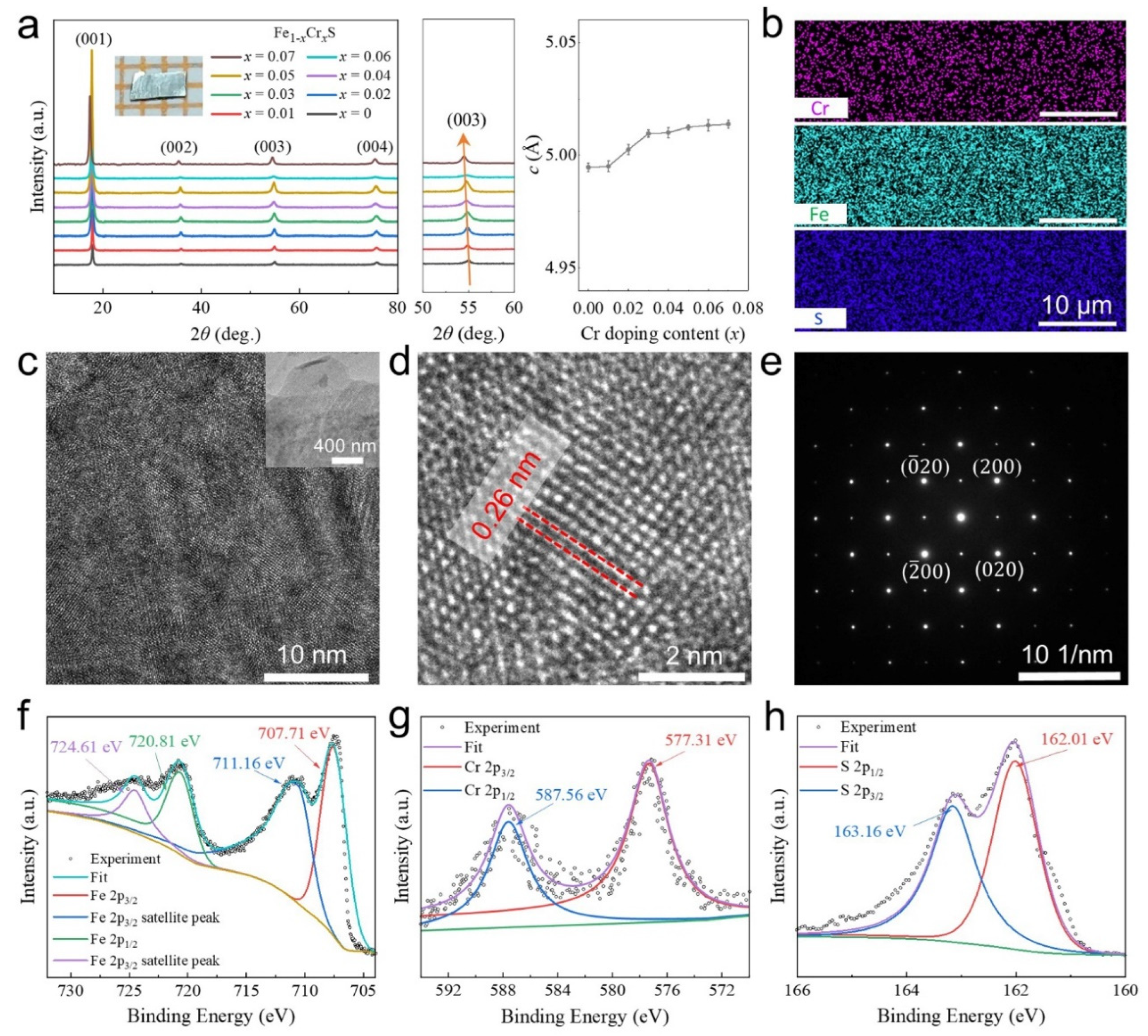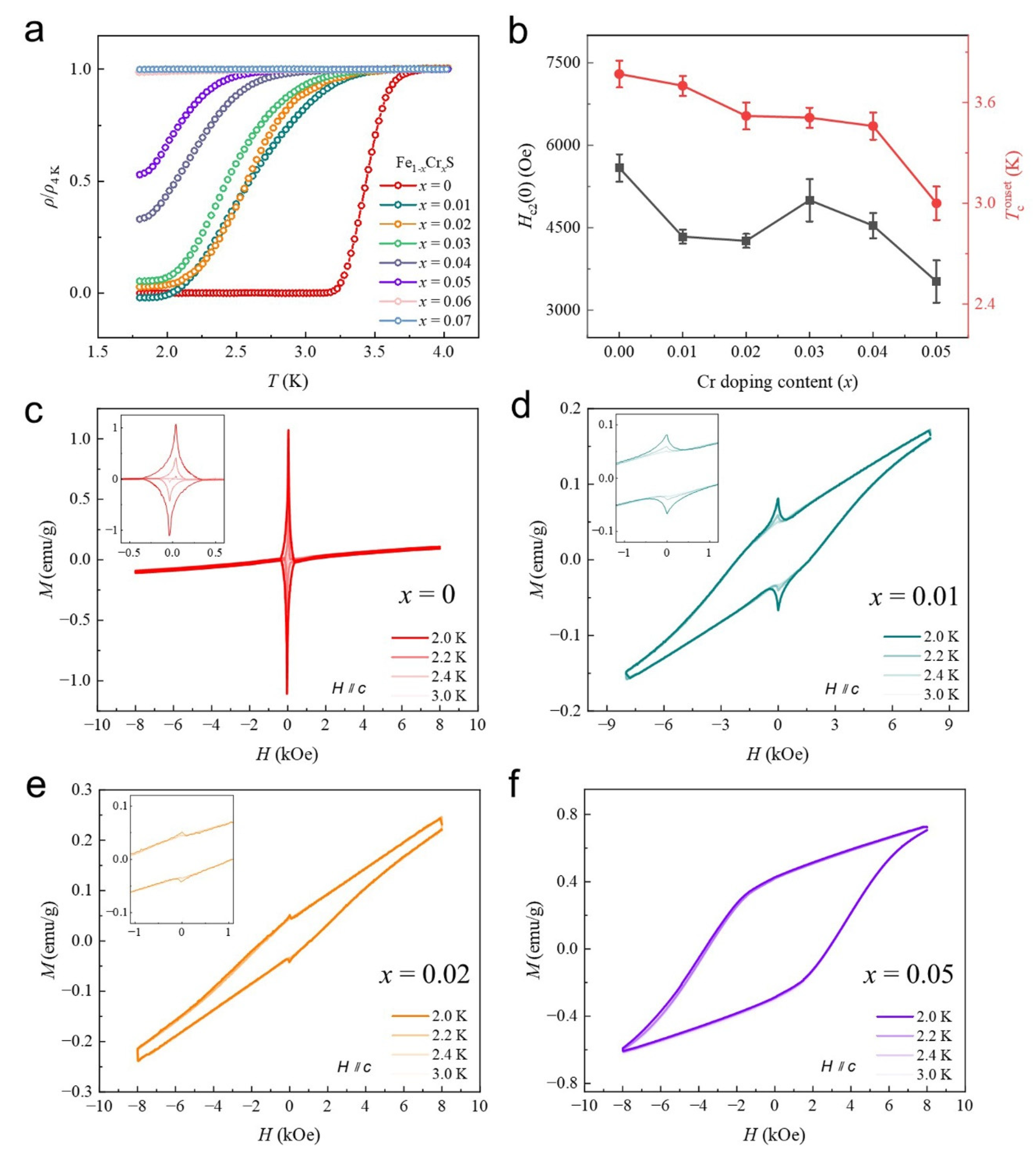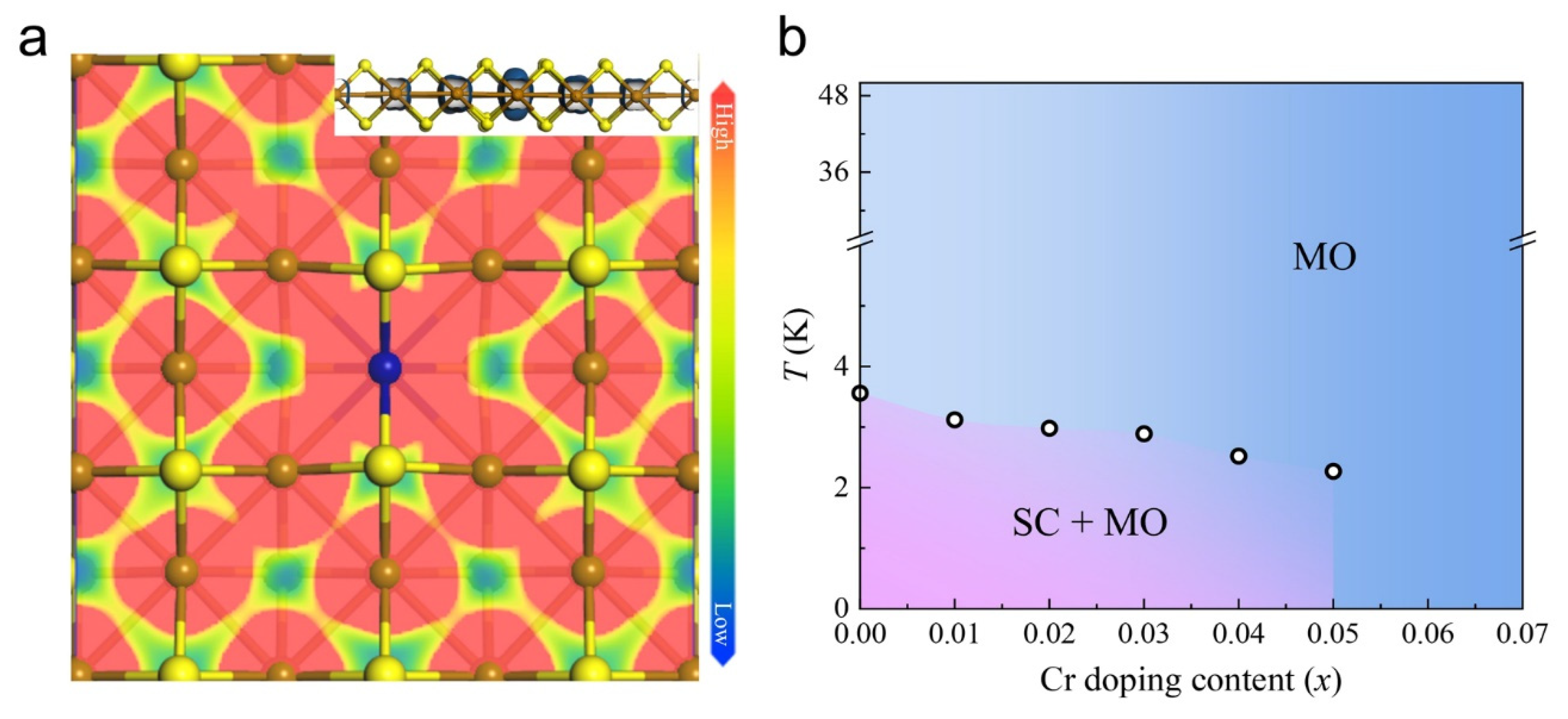Emergent Magnetic Order in Superconducting FeS Induced by Trace Cr Doping
Abstract
:1. Introduction
2. Materials and Methods
2.1. Sample Preparation
2.2. Measurements
2.3. DFT Calculations
3. Results and Discussion
3.1. The Proposed Model and Electronic Properties of Cr-Doped FeS
3.2. Crystal Structures and Transport Measurement Analysis on Cr-Doped FeS
3.3. Collective Ordering Transitions in Fe1−xCrxS (0 ≤ x ≤ 0.07)
3.4. Anisotropic Superconductivity
3.5. Electron Correlations and Resulting Phase Diagram of Fe1−xCrxS (0 ≤ x ≤ 0.07)
4. Conclusions
Supplementary Materials
Author Contributions
Funding
Institutional Review Board Statement
Informed Consent Statement
Data Availability Statement
Conflicts of Interest
Abbreviations
| SC | superconductivity |
| MOs | magnetic orders |
| DFT | density functional theory |
| FM | ferromagnetic |
| AFM | antiferromagnetism |
| XRD | X-ray diffraction |
| STEM | scanning transmission electron microscopy |
| SAEDs | selected area electron diffractions |
| XPS | X-ray photoelectron spectroscopy |
| RKKY | Ruderman–Kittel–Kasuya–Yosida |
| EF | Fermi level |
| DOS | density of states |
| EDS | energy-dispersive X-ray spectroscopy |
| QD | Quantum Design |
| SQUID | Superconducting Quantum Interference Device |
| VASP | Vienna ab initio simulation package |
| GGA | generalized gradient approximation |
| PAW | projector augmented wave |
References
- Fertig, W.A.; Johnston, D.C.; DeLong, L.E.; McCallum, R.W.; Maple, M.B.; Matthias, B.T. Destruction of Superconductivity at the Onset of Long-Range Magnetic Order in the Compound ErRh4B4. Phys. Rev. Lett. 1977, 38, 987–990. [Google Scholar] [CrossRef]
- Zaki, N.; Gu, G.; Tsvelik, A.; Wu, C.; Johnson, P.D. Time-reversal symmetry breaking in the Fe-chalcogenide superconductors. Proc. Natl. Acad. Sci. USA 2021, 118, e2007241118. [Google Scholar] [CrossRef] [PubMed]
- McLaughlin, N.J.; Wang, H.; Huang, M.; Lee-Wong, E.; Hu, L.; Lu, H.; Yan, G.Q.; Gu, G.; Wu, C.; You, Y.-Z.; et al. Strong Correlation Between Superconductivity and Ferromagnetism in an Fe-Chalcogenide Superconductor. Nano Lett. 2021, 21, 7277–7283. [Google Scholar] [CrossRef] [PubMed]
- Farhang, C.; Zaki, N.; Wang, J.; Gu, G.; Johnson, P.D.; Xia, J. Revealing the Origin of Time-Reversal Symmetry Breaking in Fe-Chalcogenide Superconductor FeTe1-xSex. Phys. Rev. Lett. 2023, 130, 046702. [Google Scholar] [CrossRef]
- Qiu, G.; Yang, H.-Y.; Hu, L.; Zhang, H.; Chen, C.-Y.; Lyu, Y.; Eckberg, C.; Deng, P.; Krylyuk, S.; Davydov, A.V.; et al. Emergent ferromagnetism with superconductivity in Fe(Te,Se) van der Waals Josephson junctions. Nat. Commun. 2023, 14, 6691. [Google Scholar] [CrossRef]
- Lu, Y.; Tokatly, I.; Bergeret, S.F. Ferromagnetic ordering of magnetic impurities mediated by supercurrents in the presence of spin-orbit coupling. Phys. Rev. B 2023, 108, L180506. [Google Scholar] [CrossRef]
- Pfleiderer, C.; Uhlarz, M.; Hayden, S.M.; Vollmer, R.; Löhneysen, H.; Bernhoeft, N.R.; Lonzarich, G.G. Coexistence of superconductivity and ferromagnetism in the d-band metal ZrZn2. Nature 2001, 412, 58–61. [Google Scholar] [CrossRef]
- Aoki, D.; Huxley, A.; Ressouche, E.; Braithwaite, D.; Flouquet, J.; Brison, J.P.; Lhotel, E.; Paulsen, C. Coexistence of superconductivity and ferromagnetism in URhGe. Nature 2001, 413, 613–616. [Google Scholar] [CrossRef]
- Ning, Z.; Qian, J.; Liu, Y.; Chen, F.; Zhang, M.; Deng, L.; Yuan, X.; Ge, Q.; Jin, H.; Zhang, G.; et al. Coexistence of Ferromagnetism and Superconductivity at KTaO3 Heterointerfaces. Nano Lett. 2024, 24, 7134–7141. [Google Scholar] [CrossRef]
- Yi, H.; Yao, X.; Jain, D.; Chan, Y.-T.; Chen, A.-H.; Brahlek, M.; Kisslinger, K.; Du, K.; Han, M.-G.; Zhu, Y.; et al. Universal Superconductivity in FeTe and All-Iron-BasedFerromagnetic Superconductor Heterostructures. Adv. Funct. Mater. 2025, 2418259. [Google Scholar] [CrossRef]
- Huang, C.-H.; Skurativska, A.; Bergeret, F.S.; Cazalilla, M.A. Probing magnetic and triplet correlations in spin-split superconductors with magnetic impurities. Phys. Rev. Res. 2024, 6, 033022. [Google Scholar] [CrossRef]
- Wan, W.; Dreher, P.; Muñoz-Segovia, D.; Harsh, R.; Guo, H.; Martínez-Galera, A.J.; Guinea, F.; de Juan, F.; Ugeda, M.M. Observation of Superconducting Collective Modes from Competing Pairing Instabilities in Single-Layer NbSe2. Adv. Mater. 2022, 34, 2206078. [Google Scholar] [CrossRef] [PubMed]
- Cao, Y.; Setty, C.; Kreisel, A.; Fanfarillo, L.; Hirschfeld, P.J. Spin fluctuations in the ultranodal superconducting state of Fe(Se,S). Phys. Rev. B 2024, 110, L020503. [Google Scholar] [CrossRef]
- Yin, J.-X.; Wu, Z.; Wang, J.-H.; Ye, Z.-Y.; Gong, J.; Hou, X.-Y.; Shan, L.; Li, A.; Liang, X.-J.; Wu, X.-X.; et al. Observation of a robust zero-energy bound state in iron-based superconductor Fe(Te,Se). Nat. Phys. 2015, 11, 543–546. [Google Scholar] [CrossRef]
- Chen, C.; Jiang, K.; Zhang, Y.; Liu, C.; Liu, Y.; Wang, Z.; Wang, J. Atomic line defects and zero-energy end states in monolayer Fe(Te,Se) high-temperature superconductors. Nat. Phys. 2020, 16, 536–541. [Google Scholar] [CrossRef]
- Xing, J.; Lin, H.; Li, Y.; Li, S.; Zhu, X.; Yang, H.; Wen, H.-H. Nodal superconducting gap in tetragonal FeS. Phys. Rev. B 2016, 93, 104520. [Google Scholar] [CrossRef]
- Ying, T.; Lai, X.; Hong, X.; Xu, Y.; He, L.; Zhang, J.; Wang, M.; Yu, Y.; Huang, F.; Li, S. Nodal superconductivity in FeS: Evidence from quasiparticle heat transport. Phys. Rev. B 2016, 94, 100504. [Google Scholar] [CrossRef]
- Holenstein, S.; Pachmayr, U.; Guguchia, Z.; Kamusella, S.; Khasanov, R.; Amato, A.; Baines, C.; Klauss, H.H.; Morenzoni, E.; Johrendt, D.; et al. Coexistence of low-moment magnetism and superconductivity in tetragonal FeS and suppression of Tc under pressure. Phys. Rev. B 2016, 93, 140506. [Google Scholar] [CrossRef]
- Tan, C.; Ying, T.; Ding, Z.; Zhang, J.; MacLaughlin, D.E.; Bernal, O.O.; Ho, P.C.; Huang, K.; Watanabe, I.; Li, S.Y.; et al. Nodal superconductivity coexists with low-moment static magnetism in single-crystalline tetragonal FeS: A muon spin relaxation and rotation study. Phys. Rev. B 2018, 97, 174524. [Google Scholar] [CrossRef]
- Subedi, A.; Zhang, L.; Singh, D.J.; Du, M. Density functional study of FeS, FeSe, and FeTe: Electronic structure, magnetism, phonons, and superconductivity. Phys. Rev. B 2008, 78, 134514. [Google Scholar] [CrossRef]
- Wang, B.; Yao, Y.; Hong, W.; Hong, Z.; He, X.; Wang, T.; Jian, C.; Ju, Q.; Cai, Q.; Sun, Z.; et al. The Controllable Synthesis of High-Quality Two-Dimensional Iron Sulfide with Specific Phases. Small 2023, 19, 202207325. [Google Scholar] [CrossRef]
- Song, C.-L.; Wang, Y.-L.; Cheng, P.; Jiang, Y.-P.; Li, W.; Zhang, T.; Li, Z.; He, K.; Wang, L.; Jia, J.-F.; et al. Direct Observation of Nodes and Twofold Symmetry in FeSe Superconductor. Science 2011, 332, 1410–1413. [Google Scholar] [CrossRef]
- Fernandes, R.M.; Coldea, A.I.; Ding, H.; Fisher, I.R.; Hirschfeld, P.J.; Kotliar, G. Iron pnictides and chalcogenides: A new paradigm for superconductivity. Nature 2022, 601, 35–44. [Google Scholar] [CrossRef] [PubMed]
- Skornyakov, S.L.; Leonov, I. Correlated electronic structure, orbital-dependent correlations, and Lifshitz transition in tetragonal FeS. Phys. Rev. B 2019, 100, 235123. [Google Scholar] [CrossRef]
- Shimizu, M.; Takemori, N.; Guterding, D.; Jeschke, H.O. Two-Dome Superconductivity in FeS Induced by a Lifshitz Transition. Phys. Rev. Lett. 2018, 121, 137001. [Google Scholar] [CrossRef]
- Guo, Z.; Sun, F.; Han, B.; Lin, K.; Zhou, L.; Yuan, W. Iron vacancy in tetragonal FeS crystals and its effect on the structure and superconductivity. Phys. Chem. Chem. Phys. 2017, 19, 9000–9006. [Google Scholar] [CrossRef] [PubMed]
- Kuhn, S.J.; Kidder, M.K.; Parker, D.S.; dela Cruz, C.; McGuire, M.A.; Chance, W.M.; Li, L.; Debeer-Schmitt, L.; Ermentrout, J.; Littrell, K.C.; et al. Structure and property correlations in FeS. Physica C 2017, 534, 29–36. [Google Scholar] [CrossRef]
- Borg, C.K.H.; Zhou, X.; Eckberg, C.; Campbell, D.J.; Saha, S.R.; Paglione, J.; Rodriguez, E.E. Strong anisotropy in nearly ideal tetrahedral superconducting FeS single crystals. Phys. Rev. B 2016, 93, 094522. [Google Scholar] [CrossRef]
- Lai, X.; Liu, Y.; Lü, X.; Zhang, S.; Bu, K.; Jin, C.; Zhang, H.; Lin, J.; Huang, F. Suppression of superconductivity and structural phase transitions under pressure in tetragonal FeS. Sci. Rep. 2016, 6, 31077. [Google Scholar] [CrossRef]
- Zhang, J.; Liu, F.-L.; Ying, T.-P.; Li, N.-N.; Xu, Y.; He, L.-P.; Hong, X.-C.; Yu, Y.-J.; Wang, M.-X.; Shen, J.; et al. Observation of two superconducting domes under pressure in tetragonal FeS. NPJ Quantum Mater. 2017, 2, 49. [Google Scholar] [CrossRef]
- Zhao, C.; Yi, X.; Hou, Q.; Feng, J.; Zhang, Y.; Xu, M.; Shi, Z. Hydrothermal Synthesis and Transport Properties of FeS1-xTex(0 ≤ x ≤ 0.15) Single Crystals. J. Supercond. Novel Magn. 2021, 34, 2565–2572. [Google Scholar] [CrossRef]
- Wang, A.; Wu, L.; Du, Q.; Naamneh, M.; Brito, W.H.; Abeykoon, A.M.; Pudelko, W.R.; Jandke, J.; Liu, Y.; Plumb, N.C.; et al. Mooij Law Violation from Nanoscale Disorder. Nano Lett. 2022, 22, 6900–6906. [Google Scholar] [CrossRef] [PubMed]
- Wu, H.; Amin, A.; Yu, Y.; Agterberg, D.F. Nematic Bogoliubov Fermi surfaces from magnetic toroidal order in FeSe1-xSx. Phys. Rev. B 2024, 109, 220501. [Google Scholar] [CrossRef]
- Hanaguri, T.; Iwaya, K.; Kohsaka, Y.; Machida, T.; Watashige, T.; Kasahara, S.; Shibauchi, T.; Matsuda, Y. Two distinct superconducting pairing states divided by the nematic end point in FeSe1-xSx. Sci. Adv. 2018, 4, eaar6419. [Google Scholar] [CrossRef] [PubMed]
- Yang, Y.; Wang, W.-S.; Lu, H.-Y.; Xiang, Y.-Y.; Wang, Q.-H. Electronic structure and dx2-y2-wave superconductivity in FeS. Phys. Rev. B 2016, 93, 104514. [Google Scholar] [CrossRef]
- Ma, R.; Han, J.; Yuan, P.; Wu, C.; Wang, Y.; Lv, W.; Ge, J.; Feng, Z.; Cao, S.; Zhang, J.; et al. Exchange Bias in Tetragonal Fe1-xNixS Single Crystals with a Short-Range Antiferromagnetism. J. Low Temp. Phys. 2023, 210, 260–270. [Google Scholar] [CrossRef]
- Yuan, P.; Han, J.; Cheng, P.; Ma, R.; Xiao, Q.; Ge, J.; Feng, Z.; Cao, S.; Zhang, J.; Lu, W.; et al. Emergence of exchange bias field in FeS superconductor with cobalt-doping. J. Phys. Condens. Matter 2021, 33, 335601. [Google Scholar] [CrossRef]
- Ruderman, M.A.; Kittel, C. Indirect Exchange Coupling of Nuclear Magnetic Moments by Conduction Electrons. Phys. Rev. 1954, 96, 99–102. [Google Scholar] [CrossRef]
- Kasuya, T. A Theory of Metallic Ferro- and Antiferromagnetism on Zener’s Model. Prog. Theor. Phys. 1956, 16, 45–57. [Google Scholar] [CrossRef]
- Yosida, K. Magnetic Properties of Cu-Mn Alloys. Phys. Rev. 1957, 106, 893–898. [Google Scholar] [CrossRef]
- Perdew, J.P.; Burke, K.; Ernzerhof, M. Generalized Gradient Approximation Made Simple. Phys. Rev. Lett. 1996, 77, 3865–3868. [Google Scholar] [CrossRef] [PubMed]
- Blöchl, P.E. Projector augmented-wave method. Phys. Rev. B 1994, 50, 17953–17979. [Google Scholar] [CrossRef]
- Kresse, G.; Joubert, D. From ultrasoft pseudopotentials to the projector augmented-wave method. Phys. Rev. B 1999, 59, 1758–1775. [Google Scholar] [CrossRef]
- Grimme, S.; Antony, J.; Ehrlich, S.; Krieg, H. A consistent and accurate ab initio parametrization of density functional dispersion correction (DFT-D) for the 94 elements H-Pu. J. Chem. Phys. 2010, 132, 154104. [Google Scholar] [CrossRef]
- Lai, X.; Zhang, H.; Wang, Y.; Wang, X.; Zhang, X.; Lin, J.; Huang, F. Observation of Superconductivity in Tetragonal FeS. J. Am. Chem. Soc. 2015, 137, 10148–10151. [Google Scholar] [CrossRef] [PubMed]
- Lin, H.; Li, Y.; Deng, Q.; Xing, J.; Liu, J.; Zhu, X.; Yang, H.; Wen, H. Multiband superconductivity and large anisotropy in FeS crystals. Phys. Rev. B 2016, 93, 144505. [Google Scholar] [CrossRef]
- Vivanco, H.K.; Rodriguez, E.E. The intercalation chemistry of layered iron chalcogenide superconductors. J. Solid State Chem. 2016, 242, 3–21. [Google Scholar] [CrossRef]
- Wang, J.; Han, J.; Chen, S.; Li, J.; Wang, Y.; Wu, C.; Wang, Q.; Wang, Z.; Chen, F.; Wan, W. Observation of a V-Shape Superconductivity Evolution on Tungsten-Intercalated 2H-Type Niobium Diselenide. ACS Nano 2024, 18, 27665–27671. [Google Scholar] [CrossRef]
- Zhou, X.; Eckberg, C.; Wilfong, B.; Liou, S.-C.; Vivanco, H.K.; Paglione, J.; Rodriguez, E.E. Superconductivity and magnetism in iron sulfides intercalated by metal hydroxides. Chem. Sci. 2017, 8, 3781–3788. [Google Scholar] [CrossRef]
- Liu, L.; Yu, Q.; Xia, J.; Shi, W.; Wang, D.; Wu, J.; Xie, L.; Chen, Y.; Jiao, L. 2D Air-Stable Nonlayered Ferrimagnetic FeCr2S4 Crystals Synthesized via Chemical Vapor Deposition. Adv. Mater. 2024, 36, 202401338. [Google Scholar] [CrossRef]
- Kwon, K.D.; Refson, K.; Sposito, G. Transition metal incorporation into mackinawite (tetragonal FeS). Am. Mineral. 2015, 100, 1509–1517. [Google Scholar] [CrossRef]
- Craco, L.; Leoni, S. Selective orbital reconstruction in tetragonal FeS: A density functional dynamical mean-field theory study. Sci. Rep. 2017, 7, 46439. [Google Scholar] [CrossRef] [PubMed]
- Pervin, R.; Krishnan, M.; Sonachalam, A.; Shirage, P.M. Coexistence of superconductivity and ferromagnetism in defect-induced NbSe2 single crystals. J. Mater. Sci. 2019, 54, 11903–11912. [Google Scholar] [CrossRef]
- Thakur, G.S.; Fuchs, G.; Nenkov, K.; Haque, Z.; Gupta, L.C.; Ganguli, A.K. Coexistence of superconductivity and ferromagnetism in Sr0.5Ce0.5FBiS2-xSex (x = 0.5 and 1.0), a non-U material with Tc < TFM. Sci. Rep. 2016, 6, 37527. [Google Scholar] [CrossRef]
- Saxena, S.S.; Agarwal, P.; Ahilan, K.; Grosche, F.M.; Haselwimmer, R.K.W.; Steiner, M.J.; Pugh, E.; Walker, I.R.; Julian, S.R.; Monthoux, P.; et al. Superconductivity on the border of itinerant-electron ferromagnetism in UGe. Nature 2000, 406, 587–592. [Google Scholar] [CrossRef] [PubMed]
- Tinkham, M.; Emery, V. Introduction to Superconductivity; Mac-Graw-Hill Inc.: New York, NY, USA, 1996. [Google Scholar]
- Ouassou, J.A.; Yokoyama, T.; Linder, J. RKKY interaction in triplet superconductors: Dzyaloshinskii-Moriya-type interaction mediated by spin-polarized Cooper pairs. Phys. Rev. B 2024, 109, 174506. [Google Scholar] [CrossRef]
- Xu, H.; Chung, C.-M.; Qin, M.; Schollwöck, U.; White, S.R.; Zhang, S. Coexistence of superconductivity with partially filled stripes in the Hubbard model. Science 2024, 384, eadh7691. [Google Scholar] [CrossRef]
- Wan, W.; Harsh, R.; Dreher, P.; de Juan, F.; Ugeda, M.M. Superconducting dome by tuning through a van Hove singularity in a two-dimensional metal. npj 2d Mater. Appl. 2023, 7, 41. [Google Scholar] [CrossRef]
- Winkler, R.; Ciria, M.; Ahmad, M.; Plank, H.; Marcuello, C. A Review of the Current State of Magnetic Force Microscopy to Unravel the Magnetic Properties of Nanomaterials Applied in Biological Systems and Future Directions for Quantum Technologies. Nanomaterials 2023, 13, 2585. [Google Scholar] [CrossRef]





Disclaimer/Publisher’s Note: The statements, opinions and data contained in all publications are solely those of the individual author(s) and contributor(s) and not of MDPI and/or the editor(s). MDPI and/or the editor(s) disclaim responsibility for any injury to people or property resulting from any ideas, methods, instructions or products referred to in the content. |
© 2025 by the authors. Licensee MDPI, Basel, Switzerland. This article is an open access article distributed under the terms and conditions of the Creative Commons Attribution (CC BY) license (https://creativecommons.org/licenses/by/4.0/).
Share and Cite
Wang, Y.; Wang, Q.; Dong, Y.; Wang, J.; Chen, S.; Wang, Z.; Chen, F.; Cao, G.; Ren, W.; Li, J.; et al. Emergent Magnetic Order in Superconducting FeS Induced by Trace Cr Doping. Materials 2025, 18, 2108. https://doi.org/10.3390/ma18092108
Wang Y, Wang Q, Dong Y, Wang J, Chen S, Wang Z, Chen F, Cao G, Ren W, Li J, et al. Emergent Magnetic Order in Superconducting FeS Induced by Trace Cr Doping. Materials. 2025; 18(9):2108. https://doi.org/10.3390/ma18092108
Chicago/Turabian StyleWang, Yangzhou, Qianshuo Wang, Yanhao Dong, Jin Wang, Shu Chen, Zihan Wang, Fei Chen, Guixin Cao, Wei Ren, Jie Li, and et al. 2025. "Emergent Magnetic Order in Superconducting FeS Induced by Trace Cr Doping" Materials 18, no. 9: 2108. https://doi.org/10.3390/ma18092108
APA StyleWang, Y., Wang, Q., Dong, Y., Wang, J., Chen, S., Wang, Z., Chen, F., Cao, G., Ren, W., Li, J., & Wan, W. (2025). Emergent Magnetic Order in Superconducting FeS Induced by Trace Cr Doping. Materials, 18(9), 2108. https://doi.org/10.3390/ma18092108







